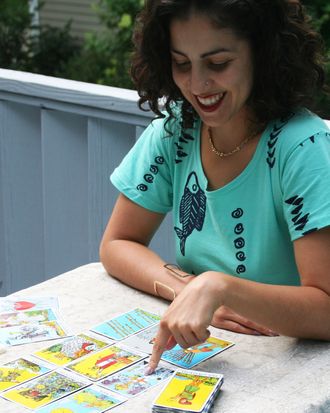
Like most of her fans, I first encountered Jessica Dore on Twitter. An acquaintance of mine retweeted one of her daily readings into my feed, and I was taken with her simple, subtly political interpretation of the Three of Cups card. These thoughtful (and free) one-card readings have become Dore’s business card, of sorts: every day, she pulls a card from one of her decks and posts the image to Twitter, along with her interpretation of its meaning. Through them, she’s amassed nearly 10,000 Twitter followers in the span of a year.
As the owner of three — wait, four — tarot decks, two tarot guidebooks, and an assortment of crystals, I’m Dore’s target demo, but I’m also a skeptic who tunes out when people start talking about astrology or chakras. What made Dore’s take on tarot so immediately appealing to me was her realism: she’s insightful without claiming otherworldly ability, and she views tarot cards not as magical tools, but practical ones. She also happens to be in the process of earning her master’s degree in social work at Edinboro University in Pennsylvania. Tarot is (for now) her side hustle, but during the day, she’s studying to become a psychotherapist, and Dore believes these approaches can be complementary.
Dore, 32, says her interest in tarot can be traced to her mother, who is also a social worker, and who had the classic Rider-Waite Smith deck around the house when Dore was growing up. (First published in 1910, Rider-Waite Smith deck is among the world’s most popular, from which many other decks are inspired.) As a college student she studied communications, and after graduation went to work as a publicist at New Harbinger, a book publisher specializing in self-help and psychology manuals and workbooks. “It was my job to translate these clinical books into ideas that would be pitchable to lay readers in mainstream media publications, and it was kind of a hard job, because the books were really dry and no one wanted to cover them,” Dore tells me.
Around the same time, Dore purchased her own first tarot deck, pulling a card everyday to familiarize herself with the images and their meanings. Soon, she realized her new hobby had substantial common ground with her job. “I noticed that there were a lot of really interesting connections between the tarot cards and what I was learning in this world of evidence-based psychology and behavioral science,” she says. As it turned out, many of the archetypes Dore saw in the cards were also present in psychology literature, and she began to see a way the two practices could be complementary. Traditionally, tarot readers pull anywhere from one to ten cards, arranged in different “spreads,” or layouts, and reveal their meanings to their subjects, who usually begin by asking a specific question. But tarot readers, like therapists, respond to the verbal cues of their clients, and the cards’ meanings — and the resulting analysis — shifts within that context. It was just a matter of making that connection.
So Dore began doing tarot readings for friends, incorporating elements of mindfulness, cognitive behavioral therapy, and other classic psychological theories she’d read so much about. Immediately, she noticed how much more deeply these otherwise clinical concepts resonated when they were delivered through the lens of tarot. “I was interested in taking these scientific concepts I was learning about and applying them in a way that was different. I could see that it was really useful, and evidence-based, but it was boring,” she says. “There has to be another way to apply it that makes more sense. When you take tarot, and you see the richness of the illustrations and the metaphors in the cards, you can draw a lot of similarities and connections to mindfulness or some of these other clinical concepts.”
Dore decided to return to school, and there, she’s incorporated tarot into her clinical work. “Last year I was doing work with clients with eating disorders and a number of other co-occurring issues,” she says. “We were using tarot in group therapy, and it was really amazing how useful it was for people, even with no [prior] knowledge of the cards.” (Praise for tarot’s therapeutic efficacy is also abundant on Dore’s Twitter feed.) While Dore was initially nervous to “come out” as a tarot reader among other professionals in her field, she says most of her peers have been surprisingly supportive. “I’ve had a lot of positive feedback from people in the behavioral science and psychology community who appreciate another perspective,” she tells me. “And it’s the same with clients in clinical work. It’s another way of looking at things, it’s another way of helping you process what you’re going through. I think when you frame it that way, people go, sure they’re just cards.” In a clinical setting, Dore says tarot cards can be an effective tool in empowering patients to draw their own conclusions, pointing to visual precedents like the Rorschach inkblot test.
“Tarot is a very non-threatening way to communicate things that would otherwise be difficult,” she says. “If I say to you ‘You’re caught up in this addictive behavior, and you’re the one who’s keeping yourself here,’ that’s something very different than pulling the devil card, which shows these people on the card with chains on, where you can see that they could get out if they chose to.” Of course, in traditional readings, the card that gets pulled is (if you don’t believe in magic) a matter of coincidence, and not every card pulled is likely to be that immediately resonant — which is part of the reason that Dore is, in clinical contexts, interested in letting patients choose those cards that stand out to them, and talking about those. “The person then can kind of make their own meaning of that,” she adds. “It makes it more digestible for people, and they can take from it what they’re ready to accept.”
None of this is to say that Dore believes tarot is the right therapeutic tool for everyone, or the only one needed; she plans to offer tarot as one available element of her own practice, but is eager to learn more about other, more traditional modalities too. For now, she does between eight and ten Skype session readings a week, which she says is all her schedule has room for. Her rate is $70 an hour, which is cheaper than most (for instance, a reader in a tiny upstate New York town I visited recently charged $90 for half an hour — I passed), but Dore says her earnings allow her to defray her costs of living as a graduate student. She’s also been approached by several book publishers wondering if she’s interested in doing a tarot book. (No deal has been made as of yet.) She’d be well within her rights to market herself as an expert, but Dore is most interested in tarot as a tool of the people. Whereas other readers might hew closely to the definitions of the cards proscribed by the little packets that come with them, Dore believes context is crucial, and that tarot is ultimately creative.
“In therapy, we’re always thinking about function,” she says. “For me, if there’s no therapeutic function for me to tell you that this card means something that has no resonance with you, then there’s no way I’m going to do that. I would much rather give people permission to practice and to use tarot knowing they don’t have to memorize their given meanings.”





